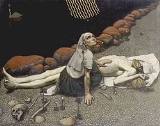
Swan of Tuonela
Encyclopedia

Finland
Finland , officially the Republic of Finland, is a Nordic country situated in the Fennoscandian region of Northern Europe. It is bordered by Sweden in the west, Norway in the north and Russia in the east, while Estonia lies to its south across the Gulf of Finland.Around 5.4 million people reside...
composer Jean Sibelius
Jean Sibelius
Jean Sibelius was a Finnish composer of the later Romantic period whose music played an important role in the formation of the Finnish national identity. His mastery of the orchestra has been described as "prodigious."...
. It is the third part of Op. 22 Lemminkäinen (Four legends), tales from the Kalevala
Kalevala
The Kalevala is a 19th century work of epic poetry compiled by Elias Lönnrot from Finnish and Karelian oral folklore and mythology.It is regarded as the national epic of Finland and is one of the most significant works of Finnish literature...
epic of Finnish mythology
Finnish mythology
Finnish mythology is the mythology that went with Finnish paganism which was practised by the Finnish people prior to Christianisation. It has many features shared with fellow Finnic Estonian mythology and its non-Finnic neighbours, the Balts and the Scandinavians...
.
The tone poem is scored for a small orchestra of oboe
Oboe
The oboe is a double reed musical instrument of the woodwind family. In English, prior to 1770, the instrument was called "hautbois" , "hoboy", or "French hoboy". The spelling "oboe" was adopted into English ca...
, cor anglais
Cor anglais
The cor anglais , or English horn , is a double-reed woodwind instrument in the oboe family....
, bass clarinet
Bass clarinet
The bass clarinet is a musical instrument of the clarinet family. Like the more common soprano B clarinet, it is usually pitched in B , but it plays notes an octave below the soprano B clarinet...
, bassoon
Bassoon
The bassoon is a woodwind instrument in the double reed family that typically plays music written in the bass and tenor registers, and occasionally higher. Appearing in its modern form in the 19th century, the bassoon figures prominently in orchestral, concert band and chamber music literature...
, 4 horn
Horn (instrument)
The horn is a brass instrument consisting of about of tubing wrapped into a coil with a flared bell. A musician who plays the horn is called a horn player ....
s, 3 trombone
Trombone
The trombone is a musical instrument in the brass family. Like all brass instruments, sound is produced when the player’s vibrating lips cause the air column inside the instrument to vibrate...
s, timpani
Timpani
Timpani, or kettledrums, are musical instruments in the percussion family. A type of drum, they consist of a skin called a head stretched over a large bowl traditionally made of copper. They are played by striking the head with a specialized drum stick called a timpani stick or timpani mallet...
, bass drum
Bass drum
Bass drums are percussion instruments that can vary in size and are used in several musical genres. Three major types of bass drums can be distinguished. The type usually seen or heard in orchestral, ensemble or concert band music is the orchestral, or concert bass drum . It is the largest drum of...
, harp
Harp
The harp is a multi-stringed instrument which has the plane of its strings positioned perpendicularly to the soundboard. Organologically, it is in the general category of chordophones and has its own sub category . All harps have a neck, resonator and strings...
, and divisi strings
String section
The string section is the largest body of the standard orchestra and consists of bowed string instruments of the violin family.It normally comprises five sections: the first violins, the second violins, the violas, the cellos, and the double basses...
. The cor anglais is the voice of the swan and its solo is perhaps the best known cor anglais solo in the orchestral literature. The music paints a gossamer, transcendental image of a mystical swan
Swan
Swans, genus Cygnus, are birds of the family Anatidae, which also includes geese and ducks. Swans are grouped with the closely related geese in the subfamily Anserinae where they form the tribe Cygnini. Sometimes, they are considered a distinct subfamily, Cygninae...
swimming around Tuonela
Tuonela
Tuonela is the realm of the dead or the Underworld in Finnish and Estonian mythology. Tuonela, Tuoni, Manala and Mana are used synonymously. In Estonian mythology, it is called Toonela or Manala....
, the island of the dead. Lemminkäinen, the hero of the epic, has been tasked with killing the sacred swan but on the way he is shot with a poisoned arrow and dies. In the next part of the epic he is restored to life.
The Swan of Tuonela was originally composed in 1893 as the prelude to a projected opera called The Building of the Boat; Sibelius revised it two years later as the second of the four sections of the Lemminkäinen Suite
Lemminkäinen Suite
The Lemminkäinen Suite is a work written by the Finnish composer Jean Sibelius in the early 1890s which forms his opus 22...
(Lemminkäis-sarja), also known as the Four Legends from the Kalevala, Op. 22, which was premiered in 1896. Sibelius revised the tone poem twice: once in 1897 and again in 1900.
Disney also planned to use the piece in a segment of Fantasia
Fantasia (film)
Fantasia is a 1940 American animated film produced by Walt Disney and released by Walt Disney Productions. The third feature in the Walt Disney Animated Classics series, the film consists of eight animated segments set to pieces of classical music conducted by Leopold Stokowski, seven of which are...
. It was planned out in storyboards but was never animated.

